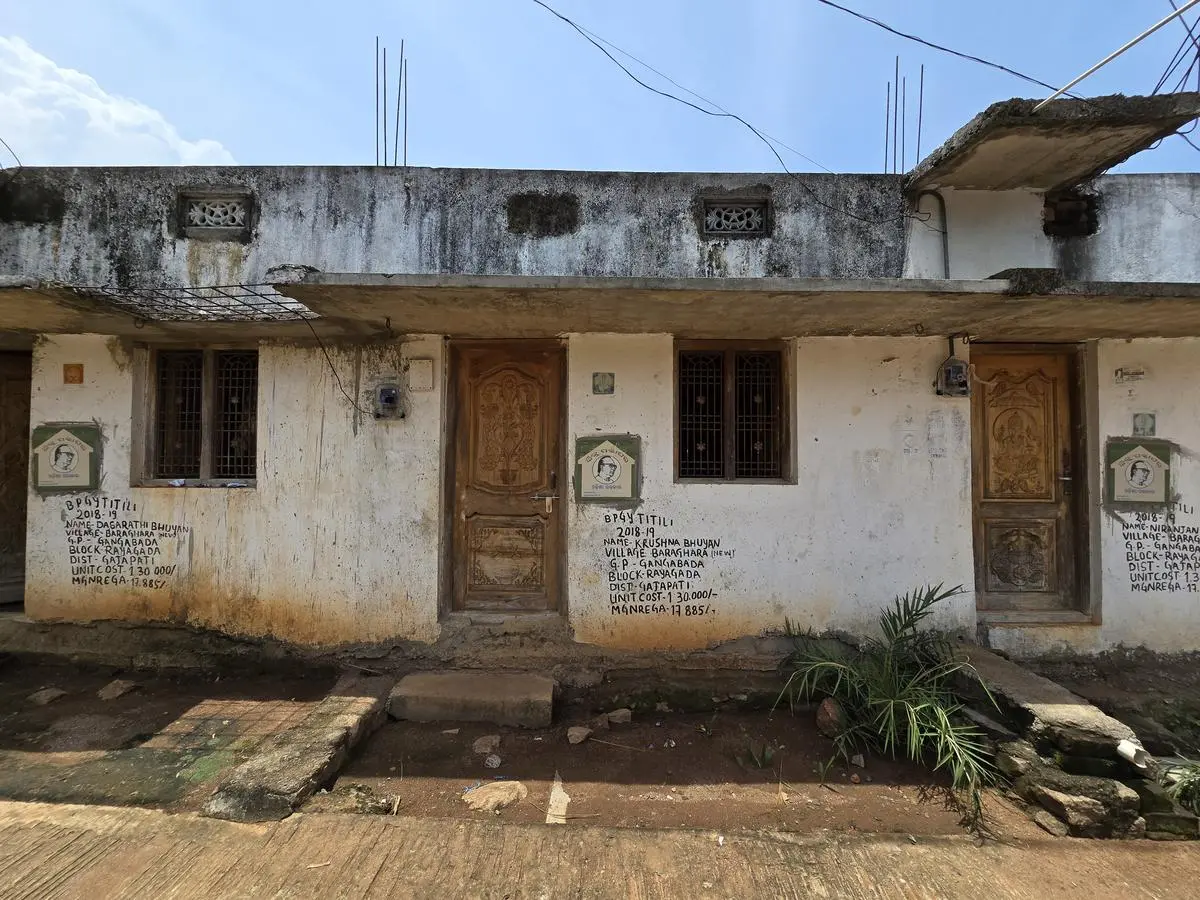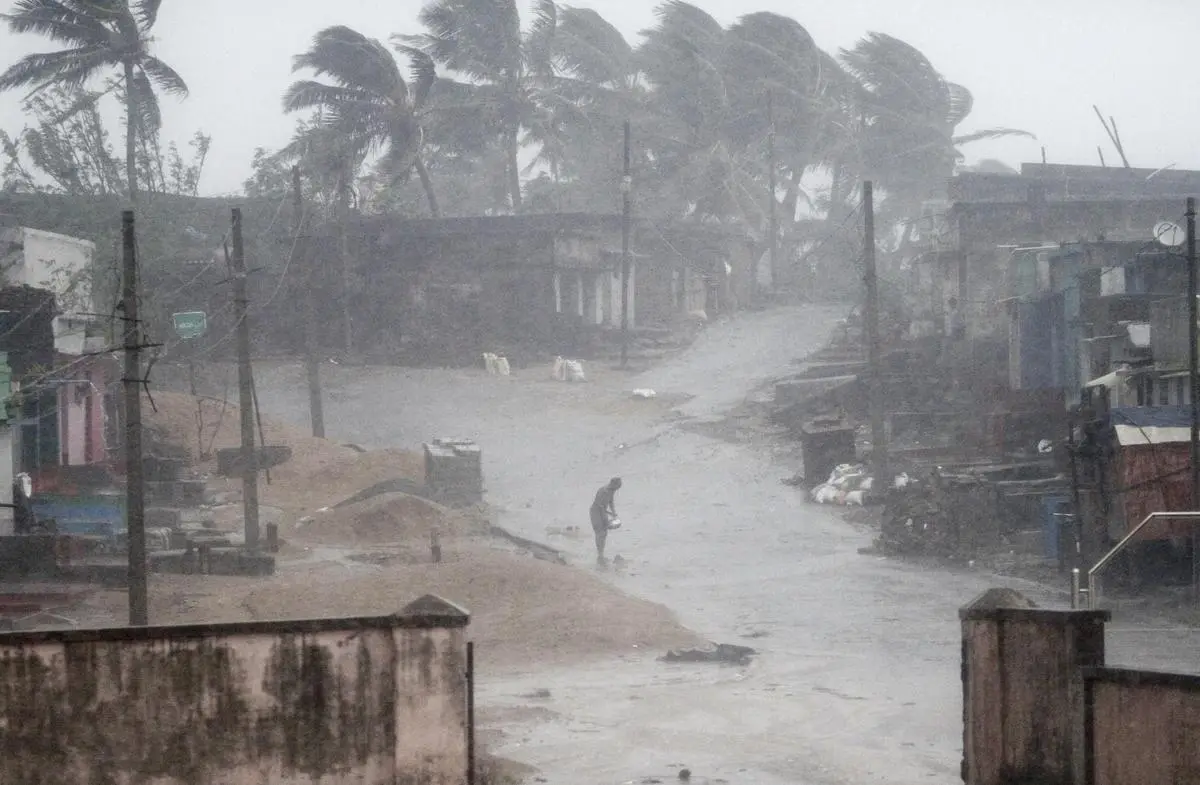“We had never experienced a cyclone, so we didn’t realise what was coming. Then we suddenly heard a loud sound—something we had never heard before. That’s when the landslide happened,” recalled Gobind Sabar, a 37-year-old agricultural labourer from Barghara.
Barghara is a small tribal village on Mahendragiri hill in the Eastern Ghats of Odisha. Cyclone Titli devastated it in 2018. The State sits at the centre of India’s cyclone belt, which runs along the East coast from West Bengal through Odisha to Andhra Pradesh and Tamil Nadu. Here, the Bay of Bengal, warmed by climate change and fed by monsoon winds, spawns some of the world’s most intense cyclones.
A low-pressure area is now brewing over the Bay of Bengal and may intensify into a cyclone in the coming days. For most of Odisha, such alerts have become routine. But for those who live in its hilly interiors, they recall what happened seven years ago when Cyclone Titli tore through the Eastern Ghats and changed the lives of the Saura, one of India’s oldest Indigenous tribes.
For decades, Odisha’s coastal districts bore the brunt of these storms. Climate change has redrawn the map. Cyclones now push further inland and strike hilly districts once considered safe.
Abinash Mohanty, an expert reviewer for the sixth assessment report of the Intergovernmental Panel on Climate Change, explained: “The cyclones in the Bay of Bengal are the result of higher sea surface temperatures, generally more than 28°C. Tropical cyclones form over warm waters, when the temperature is more than 27°C. Whether it’s pre-monsoon or post-monsoon, the Bay of Bengal’s SST [Sea Surface Temperature] is around 29°C or 30°C. The Bay of Bengal is land-locked, so it does not get any cold water.”
The Bay of Bengal is where most cyclones that hit the region form, and many make landfall here. Of the 36 deadliest tropical cyclones in the world, 27 originated in India’s East.
Also Read | Super cyclone Amphan: Bengal evacuates people from coastal areas
Ranjan Panda, a climate practitioner and Waterman of Odisha, said: “Cyclones result from depressions. Depressions are a cyclic, regular phenomenon without which we won’t get southwest and northeast monsoons. However, because of climate change, these depressions become deep depressions, and deep depressions become cyclonic storms. Historically the East coast has been a hub of cyclones and continues to be so.”
Sabar described what happened during Titli: “It swept away everyone who was in their fields on the hillside. People ran wherever they could. The roofs of our homes were damaged, so we couldn’t stay inside.”
Four other Saura villages on Mahendragiri’s slopes share Barghara’s story. The Saura are one of India’s oldest Indigenous tribes and a Particularly Vulnerable Tribal Group in Odisha. They are known for their wall paintings—Saura art—that depict ancestors, harvests, and spirits. But they face fragile farms on steep slopes, limited schools and health services, and migration, as younger generations leave for work.

Half-built abandoned houses at Nua Baraghara.
| Photo Credit:
Ashesh Sahoo
After Titli, the government relocated families far from the forests that had sustained them for generations. For centuries, they lived on Mahendragiri’s slopes and practised shifting cultivation, or podu chasa, while foraging from the forest. For them, Jagannath is not just a distant deity worshipped in Puri’s grand temple—he exists in their forest world through wooden posts or stone symbols placed under trees. Their rituals and gods connect to the land. Titli broke that bond when landslides in Gangabada panchayat, where Barghara falls, killed several people.
After the storm passed, Gobind went out to ask who had died. “The next day too, we continued asking around. The inquiry went on,” he recalled. The government then relocated them to Nua Barghara. The cyclone took their land; relocation took their way of life.
Relocation to Nua Barghara
The government moved families from three Saura villages—Barghara, Guringi, and Loba—to a new colony, Nua Barghara, 18 km away on the plains. It relocated two other villages, Bada Deola and Sana Deola, to Nua Deola, moving 120 people to the plains. Many found themselves with concrete walls but no water, farmland, or the community ties that had sustained them.
Torang Bhuiyan, 72, sat outside his mud house in Barghara and explained why he refused to move. He had been waiting, he said, to tell someone how the cyclone took his son, daughter-in-law, and granddaughter. “What will I do there if I move to Nua Barghara, Maa? It’s an empty place. People can’t even grow a seed there. What will I eat—soil? The government gave us houses to live in, and that’s it. They don’t even get water there. I’ll live here and die here.”
Before Titli, Barghara had abundant forest resources. The Saura collected broom grass (Thysanolaena maxima), made brooms, and sold them. They also collected Siali patra (Bauhinia vahlii), a large climbing vine used to make plates and bowls. “During harvest, a single family could gather so much that it would fill their entire home—it was that abundant. And because it wasn’t seasonal, we could collect and sell throughout the year. But after Titli, its availability dropped drastically and in Nua Barghara we have nothing,” Sabar said. The cyclone stripped the vegetation and left the hill bare. As the forest struggles to regenerate, families in Nua Barghara have lost access to both the land they once foraged and the knowledge tied to it.

A man standing near Aryapalli beach during rain and strong winds caused by a cyclonic storm named Titli, or Butterfly, near Gopalpur on the Bay of Bengal coast, Ganjam district, in the eastern Indian state of Orissa, on October 11, 2018.
| Photo Credit:
AP
The government funded cement houses in Nua Barghara, but the settlement lacks proper risk mapping. “We had asked the government to build the houses before relocating, and they said they would level the land and construct them for us. Later, they told us to build them ourselves, providing only the funds,” Sabar said. The money was not enough.
Under the Biju Pucca Ghar Yojana, families received Rs.1.3 lakh for construction and Rs.1.2 lakh as compensation. “We pooled funds among ourselves and did the ground levelling before starting construction,” Sabar explained. No contractors came. The community built the houses—when Sabar built his, others helped him, and when they built theirs, he helped them. Each family also received Rs.17,000 as labour compensation.
Faced with new issues
The houses trap heat. The cool mud homes of the hills gave way to cement walls that make families sick. Skin problems, rashes, malaria, and heat stroke are now common. Children suffer most.
Dasrath Bhuiyan, 28, said electricity is unreliable—the power cuts out often, and despite paying bills, it works only about 10 days a month. The charge was Rs.80 earlier; now it is Rs.110, even when barely used. “Back in Barghara the climate was cooler, and we were used to that since childhood. Here we keep falling sick, and sometimes we can’t even figure out what illness it is.”
The forest recovered slowly, but relocation compounded the loss. Away from the mountains, people lost access to the plants that once healed them. They now rely more on modern medicine. The medicinal plants once abundant on Mahendragiri hill are unavailable in the new settlement. Mahendragiri hill has a rich ecosystem with vegetation that supports several threatened endemic plants and animals. The Baida—traditional healers—used to guide the community in using local medicinal herbs such as Amla, Harada, Baheda, Rangchera, and Kundichali to treat ailments like acidity. “When we were in Mahendragiri, we lived only by taking herbal medicines. Plants were our medicine,” Dasrath recalled. Today, a single trip to the hospital costs around Rs.600.
Also Read | Odisha’s tribal groups make remarkable progress during Naveen Patnaik’s tenure
The soil here resists farming—rocky and hard to work. A border dispute with Andhra Pradesh adds to the problems. The land lies partly in Andhra Pradesh and partly in Odisha, which creates constant tension over agriculture. Back in Barghara, land was plentiful. Families grew millets like ragi, jhana, ganthia, and kangu (finger millet, foxtail millet) through podu chasa (shifting cultivation), along with gourds, pumpkins, and other vegetables. Here, even a small plot is rare. “Having even an acre is out of the question—we don’t even get land as much as the size of a hand,” Draupadi Bhuiyan said.
Life in Nua Barghara is harder than what Bhuiyan and Sabar faced in their forested home. “If we can’t even grow greens and vegetables, how are we supposed to survive here?” asked Draupadi.
In Barghara, families spent less because they grew or foraged what they needed. In the new settlement, they must buy everything from the market. Their food has changed too. In Barghara, people ate what they grew. Now they depend on purchased rice and packaged goods rather than crops from their own fields.
In Nua Barghara, families mostly collect cashews and grow a few plants around their homes. The government gave them plots for houses, not for farming. Many return to Barghara to practise shifting cultivation, but yields have dropped. Relocation reduced the area they can cultivate, and with fewer families staying, the fields lie exposed. Earlier, when everyone lived together in Barghara, they watched over the land as a community. Now, with scattered households and fewer people around, wild animals cause more damage. “Earlier, whatever seeds we sowed would grow well. Even now the seeds sprout, but who is there to watch over the fields?” Gobind said.
Those who stayed in Barghara say the land has changed. Many trees never returned after the cyclone. Those who moved to Nua Barghara are too far from the forest to use it.
Torang Bhuiyan, sitting outside his home at Baraghara.
| Photo Credit:
Dimple Behal
The Sauras have watched many plants and trees that once held ecological and cultural value decline in Barghara. One of the biggest losses is Salap, the sap of a palm tree that was fermented and consumed during festivals and daily life. For the Saura, it represented both sustenance and their connection to nature. Today, it has nearly disappeared. To taste it, families now travel to Ganjam—150 km away—to find someone who still has it or can prepare it.
Before Titli, Barghara had lemons, jackfruit, coconuts, and mango trees in abundance. The cyclone destroyed most of them and left the land covered in stones. Some trees are returning as villagers replant them.
But the changes go beyond Titli. The Sauras observe shifts in the climate. Mangoes and mahul flowers no longer bloom in their season, and when they do, the flowers often drop before fruiting. Orange trees, once common, cannot survive—the seeds refuse to sprout in the altered conditions.
Also Read | Wetlands in peril
People in Barghara now depend mostly on selling wood because other resources have disappeared. Those who moved to Nua Barghara have abandoned what they practised for generations and turned to daily wage labour.
Agriculture is no longer viable, so many families now work for wages. Some work nearby in Andhra or other parts of Odisha where prawn cultivation occurs. Others migrate farther to cities like Surat for jobs in the thread industry. Even near the settlement, daily work is scarce. People walk four to five km to find employment, often to Mandasa or Pallasa across the border in Andhra, where they plant paddy, remove weeds, and clean fields for landowners. Over a year, the community gets barely 20 to 25 days of work; in some seasons, just 10 or 12.
Government rations help but rarely suffice. Each household receives 35 kg of rice, which falls short for families of 10 members. They must buy extra from local shops, which strains their limited incomes.
Women carry the burden of both home and wage labour. With no piped water or toilets, they struggle daily. The government installed five solar-powered tanks, but only two work, and even those cannot serve 137 households. During the monsoon, when solar panels fail, water cannot be pumped. In summer, the groundwater table drops so low that extraction becomes impossible. Water is scarce for bathing, washing, and drinking.
Women fetch water. They walk back and forth three to four times daily, carrying heavy drums. “Even when we are in pain or exhausted, what can we do? This is our everyday routine. Sometimes, the heat worsens the bleeding, which makes it even harder,” Sumati Bhuiyan said. Their day begins at 4 am—first to the fields for defecation, then cooking. By 7 am, household chores are done, and they leave for wage work.
Water has also become a source of conflict. Disputes prevent villagers from accessing nearby fields or water sources. “We were not allowed to bathe at certain places or farm in nearby fields because of the land dispute,” one woman explained. In summer, scarcity sharpens tensions. When tanks dry up, families dig along the riverbanks, wait for water to seep through the soil, and collect what little emerges. They avoid neighbouring villages—clashes have made that unsafe.
Some families allotted land in Nua Barghara never built houses, unwilling to stay in a settlement with so many problems. Others started construction but left homes unfinished. A few, however, found one benefit: a school. Unlike in Barghara, where there was none, children now have access to basic education.
But festivals remain tied to Barghara. People celebrate them in the old village, not the new settlement, because the rituals connect to the land and forest. Without the forest nearby, the traditions lose their context. Amb Khai, for instance, marks the arrival of mangoes: before anyone tastes the fruit, the first mangoes are offered to the gods. Nua Khai follows the rice harvest, when freshly pounded chuda (flattened rice) is laid out in devotion. Families prepare local alcohol from Salap, drink it during the festival, and pour a few drops into the soil as a ritual offering. Mahul Khai occurs before collecting Mahul flowers, which are used for local alcohol or traditional dishes. The same reverence applies to Kamara and Kangu—nothing is consumed before it is offered to gods, goddesses, and ancestors.
Five years later, Nua Barghara feels less like home. The situation is similar in the other villages relocated to Nua Deola. The State calls it rehabilitation. For the people here, it is a trade: forests for concrete, rituals for ration cards, self-sufficiency for dependency. Festivals like Nua Khai keep memories of Barghara alive, of times when Salap was poured into the soil and the earth was treated as kin. In the new settlement, traditions survive in fragments, no longer rooted in the land that gave them meaning.
Today, life in Nua Barghara moves on much like the slow recovery of the forest they left behind. The houses stand, the water still runs short, and the memories of Mahendragiri remain part of every conversation. For many, the cyclone is no longer the disaster—they say relocation was.
Efforts were made to seek comments from Odisha State Disaster Management Authority officials and Collectorate Gajapati on the rehabilitation process; their response is awaited.
With inputs from Rashmita Behera.
This story was produced with the support of Internews’ Earth Journalism Network.
Dimple Behal is an urban planner, working at the intersection of inequality, development and environment.


